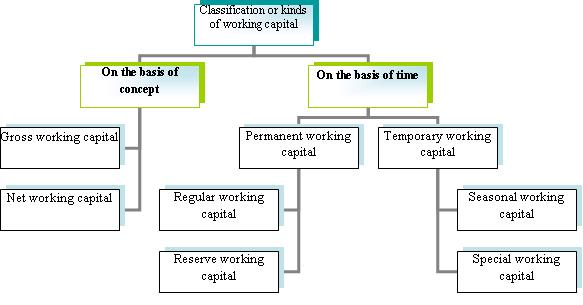Types of working capital
The working capital can be classified on the basis of concept and on the basis of time.
Types of working capital On the basis of concept
Generally there are two concepts of working capital. They are gross working capital and net working capital. But they are defined by different names. They are explained below:
1) In broad sense: working capital refers to gross working capital. It is also defined as financial concept or going concern concept. It means the capital invested in the current assets of the firm. Current assets mean the assets which can be converted into cash easily or within one accounting period. It helps in determining the return on investment in working capital and providing correct amount of working capital at right time.
2) in narrow sense: working capital refers to net working capital. It is also defined as accounting concept. It means excess of current assets over current liabilities. It helps in finding out firm’s capability to meet short term liabilities as well as indicates the financial soundness of the enterprise.
Net working capital = current assets – current liabilities
Net working capital can be +ve or –ve. When current assets are more than the current liabilities than working capital is +ve and when current assets are less than the current liabilities than working capital is –ve.
At the end we can say, that both the working capital are important but according to the suitability gross working capital is suitable for companies having separate ownership or management while net working capital is suitable for sole trader companies or partnership firms.
Types of working capital on the basis of time
1) Permanent working capital: it is also called fixed working capital. It means to carry on the day to day expenses the firm is required to maintain the minimum amount of working capital. For example the firm is required to maintain the minimum level of raw material, finished goods or cash balance etc.
a) Regular working capital- it means the minimum amount which the firm has to keep with itself to carry on the day to day operation.
b) Reserve working capital- it means the excess amount over the regular working capital for uncertain circumstances like strike, lock out, depression etc.
2) Temporary working capital: it is also called variable working capital, which is required to meet the seasonal demands as well as for special purposes.
a) Seasonal working capital- it is required to meet the seasonal needs of the enterprise.
b) Special working capital- it is required for some special purposes of the enterprise. For example advertising the product of the firm requires special working capital.
Temporary working capital is for short period and fluctuates while permanent working capital is stable and fixed.
These are the types or classification of working capital.

I likie reading your topics where I am learning a lot…..thanks po!
Thanks
i am satisfied with your information…………
Very helpfull, please I need the name of the author for reference use.
Very helpful, please I need the name of the author for reference use. thanks